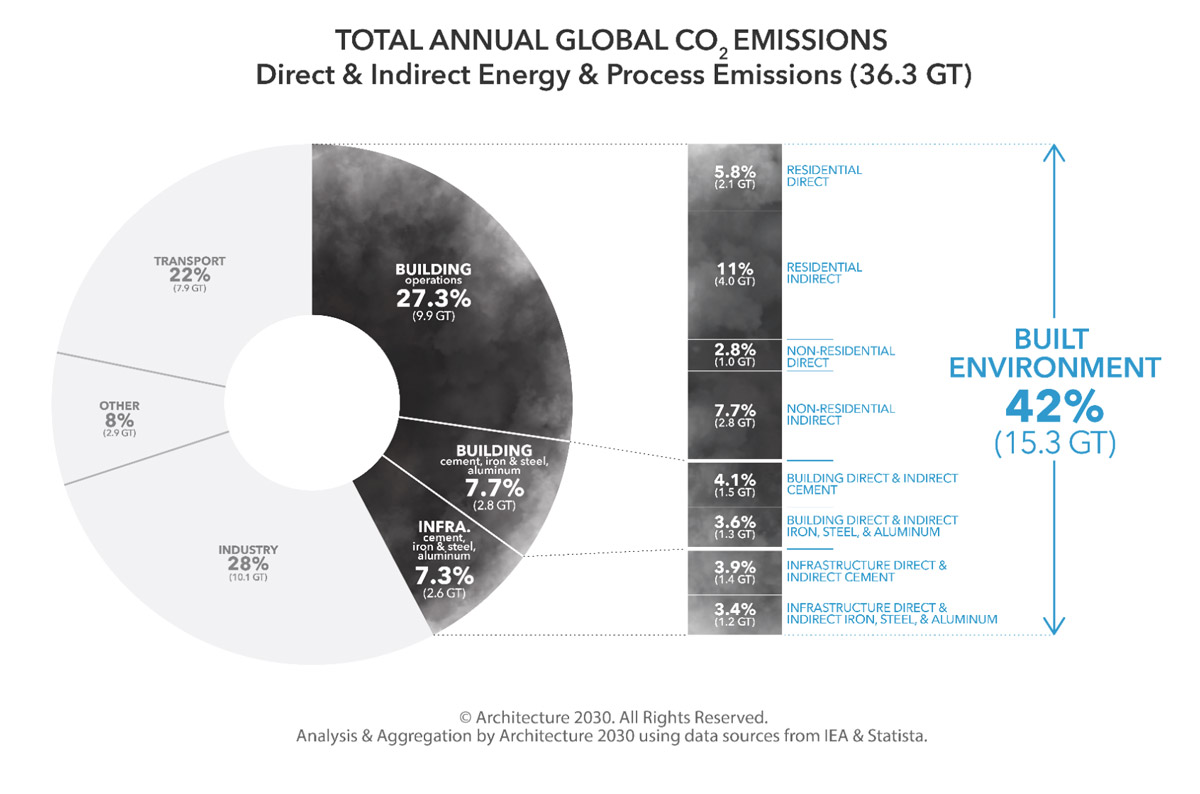Transforming Carbon Management in Design and Construction Through Digital Innovation
In an era where environmental sustainability takes center stage, industries worldwide are striving to combat climate change and minimize their carbon footprint. The construction sector, being a significant contributor to global carbon emissions, is no exception. Addressing this challenge effectively requires innovative approaches to carbon management, and digital enablement is at the forefront of this transformation.
At 2050 Materials, we are committed to revolutionising the data layer of sustainable construction. In this comprehensive article, we will explore in detail how digital enablement is reshaping carbon management in the design and construction of buildings and infrastructure, and its profound implications for a greener future.
The Carbon Challenge

Illustration by Architecture 2030
Before delving into the role of digital enablement, it’s vital to grasp the magnitude of the challenge we face. The construction industry is responsible for a substantial portion of global carbon emissions. These emissions primarily result from energy-intensive processes involved in manufacturing building materials and constructing structures. To achieve ambitious climate goals and transition to a low-carbon economy, we must take decisive steps to tackle embodied carbon within our built environment.
Embodied carbon encompasses the carbon emissions associated with the production, transportation, and construction of building materials. It represents a critical aspect of a building’s overall carbon footprint, working in tandem with operational carbon, which includes emissions from ongoing energy usage such as heating, cooling, and lighting.
Digital Enablement: A Catalyst for Carbon Management
Digital enablement in carbon management is the strategic utilization of advanced technologies, data-driven processes, and collaborative platforms to quantify, reduce, and optimize carbon emissions throughout the design and construction phases. Let’s delve into how this transformational process unfolds:
- Building Information Modeling (BIM): BIM serves as a digital twin of a building, encompassing both its physical and functional attributes. This sophisticated model empowers architects, engineers, and construction professionals to create a comprehensive 3D representation that includes data on materials, energy performance, and more. BIM facilitates informed decisions, allowing designers to make choices that minimize embodied carbon during the critical design phase.
- Life Cycle Assessment (LCA): LCA is a rigorous methodology used to quantitatively assess the environmental impact of a product or system across its entire life cycle. Within construction, LCA is applied to building materials and components. By seamlessly integrating LCA with BIM, designers can continuously evaluate the carbon footprint of various design alternatives in real time. This capability empowers them to select environmentally friendly options that effectively reduce emissions.
- Environmental Product Declarations (EPDs): EPDs provide transparent and standardized information about the environmental performance of building materials. With digital tools, architects and builders can readily access EPDs for a wide array of materials, facilitating the selection of low-carbon options. Moreover, these tools enable ongoing tracking of the embodied carbon throughout a project’s lifecycle.
- Real-Time Monitoring: The digital age brings us real-time monitoring capabilities. Sensors and Internet of Things (IoT) devices play a pivotal role in tracking energy consumption and emissions during construction. This granular data allows project managers to optimize operations for sustainability by monitoring machinery, transportation, and energy use efficiently.
- Collaboration and Integration: Digital platforms serve as collaborative hubs, bringing together various stakeholders, including architects, engineers, contractors, and material suppliers. An API-first approach, exemplified by 2050 Materials, ensures the seamless integration of sustainability data into the design process. This integration empowers stakeholders to perform real-time embodied impact calculations and fosters efficient decision-making.
The Benefits of Digital Enablement
The digital enablement of carbon management offers a plethora of benefits:
- Data-Driven Decision Making: Designers and builders can make well-informed decisions based on accurate and up-to-date carbon data. This data-driven approach results in significantly reduced embodied carbon in construction projects.
- Cost Savings: By optimizing materials and processes for sustainability, cost savings are achieved over the life of a project, making it an economically viable choice.
- Regulatory Compliance: Digital tools prepare the construction industry to meet future regulatory requirements related to carbon disclosure and reduction efficiently.
- Sustainable Collaborations: Collaborative platforms foster partnerships between industry experts, driving ongoing research and innovation in sustainable construction practices.
- Long-Term Sustainability: Forward-thinking companies like continuously explore and adopt new technologies. At 2050 Materials, we are proud to be long-term partners to these companies, committed to advancing sustainable practices in the construction sector.
Conclusion
The digital enablement of carbon management is ushering in a transformative era for the design and construction industry. Through the strategic deployment of tools such as BIM, LCA, EPDs, real-time monitoring, and collaborative platforms, professionals can effectively reduce embodied carbon, minimize environmental impact, and contribute to a more sustainable future.
At 2050 Materials, we take pride in spearheading this transformation, providing data-driven insights to shape a greener built environment. Together, we can construct a sustainable future that benefits generations to come.

Related articles

Climate-Resilient Materials for the Built Environment: A Data-Centred Prime
As climate volatility intensifies, resilience metrics are fast becoming as critical as carbon data in material selection. This article outlines why adaptation is now a design imperative, how materials can be evaluated through a systems lens, and what KPIs project teams should demand. From self-healing concrete to fire-rated façades, we present a structured taxonomy of resilient materials, explain how to embed this intelligence into digital design workflows, and propose next steps for specification, benchmarking, and procurement.
Read more
The Most Interesting Low Carbon Products in Office Design
In this article and collection, we highlight 11 outstanding products that contribute to a lower carbon footprint in office design.
Read more
Top Low Carbon Building Boards: Performance, Benefits, and Use Cases
The building boards highlighted in this article and collection showcase low-carbon innovation in modern construction.
Read more